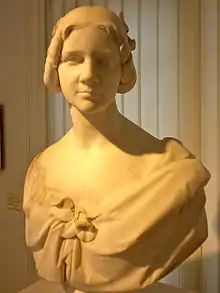Joseph Durham
Joseph Durham ARA (1814 – 27 October 1877) was an English sculptor.

Life
Durham was born in London in 1814 and was apprenticed to John Francis, a decorative carver. He later worked in the studio of E. H. Baily for three years, and exhibited his first piece of sculpture in the Royal Academy in 1835.

His busts of Jenny Lind (1848) and of Queen Victoria (1856) attracted a great deal of attention[1] the former proving particularly popular when reproduced in Parian ware by Copeland.[2] A statue by him of Sir Francis Crossley was erected at Halifax. He executed four statues for the portico of London University in Burlington Gardens.[1]
In 1858 he won the commission for the Memorial to the Great Exhibition of 1851, which ultimately included the electrotyped statue of Albert, Prince Consort following Albert's death in 1861. Durham had originally planned that the main figure should be a representation of Britannia. The Memorial was erected in the gardens of the Royal Horticultural Society at Kensington in 1863, and was moved to a site near the Royal Albert Hall in around 1890.[3] A commission from the Duke of Buccleuch, a statue of the Duke's younger brother – John Douglas Montagu Douglas Scott – was erected in Dunchurch and unveiled by the Duke in September 1867.
Between 1835 and 1878 Durham exhibited 126 pieces of sculpture at the Royal Academy and six at the British Institution. He was noted for his figures of boys engaged in sporting activities.[1] A porcelain reproduction of his sculpture Go to Sleep was distributed as a prize to members of the Art Union of London in 1865.[4] He became an associate of the Royal Academy in 1866.[1] One of his major works was a Leander and the Syren, exhibited at the Royal Academy in 1875. His statues entitled Hermione and Alastor were purchased for the Mansion House.[1]
He died after a long illness, on 27 October 1877,[1] at his home at 21 Devonshire Street, London.[5] He is buried in Kensal Green Cemetery.
References
- . Dictionary of National Biography. London: Smith, Elder & Co. 1885–1900.
- Walford, Edward T. (1862). Men of the Time: A Biographical Dictionary of Eminent Living Characters. London: Routledge, Warne & Routledge. p. 246.
- Sheppard, F. H. W., ed. (1975). "The Memorial to the Exhibition of 1851". Survey of London: volume 38: South Kensington Museums Area. Institute of Historical Research. Retrieved 6 November 2011.
- "Art Union of London: Exhibition of Prizes". The Art Journal. 4: 289. 1865.
- Obituary, The Architect, 3 November 1877, p. 247.
- Attribution
![]() This article incorporates text from a publication now in the public domain: "Durham, Joseph". Dictionary of National Biography. London: Smith, Elder & Co. 1885–1900.
This article incorporates text from a publication now in the public domain: "Durham, Joseph". Dictionary of National Biography. London: Smith, Elder & Co. 1885–1900.
External links
| Wikimedia Commons has media related to Joseph Durham. |
- 29 paintings by or after Joseph Durham at the Art UK site